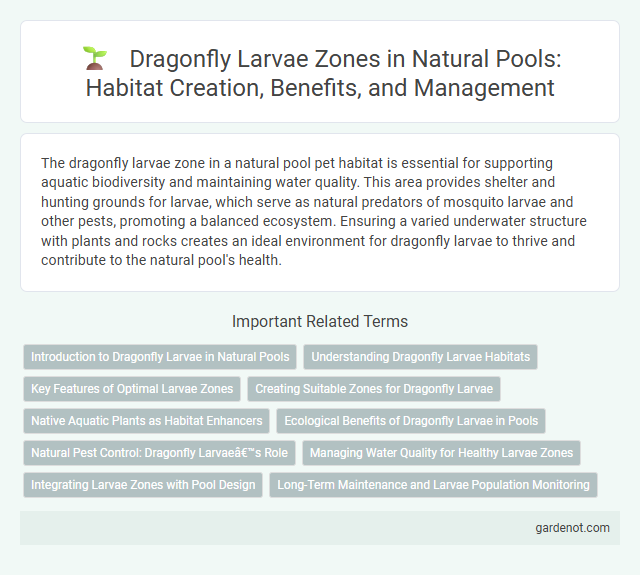The dragonfly larvae zone in a natural pool pet habitat is essential for supporting aquatic biodiversity and maintaining water quality. This area provides shelter and hunting grounds for larvae, which serve as natural predators of mosquito larvae and other pests, promoting a balanced ecosystem. Ensuring a varied underwater structure with plants and rocks creates an ideal environment for dragonfly larvae to thrive and contribute to the natural pool's health.
Introduction to Dragonfly Larvae in Natural Pools
Dragonfly larvae play a crucial role in natural pools as effective biological control agents, feeding on mosquito larvae and other small aquatic insects. These larvae inhabit the shallow, vegetated zones of natural pools where water quality is high and aquatic plants provide shelter and hunting grounds. Maintaining a diverse plant ecosystem fosters a thriving dragonfly larvae population, enhancing biodiversity and natural pest management.
Understanding Dragonfly Larvae Habitats
Dragonfly larvae thrive in shallow, still water zones with abundant submerged vegetation, which provides shelter and hunting grounds for aquatic insects. These habitats are crucial in natural pools, as they support larvae development while promoting biodiversity and water quality through natural pest control. Understanding the specific requirements of dragonfly larvae habitats helps in designing natural pools that encourage their presence and ecological balance.
Key Features of Optimal Larvae Zones
Optimal dragonfly larvae zones in natural pools feature shallow, calm waters with abundant submerged vegetation, providing shelter and hunting grounds. These zones maintain stable temperature and oxygen levels, crucial for larvae development and survival. A balanced ecosystem with minimal pollutant exposure enhances larvae growth and supports biodiversity.
Creating Suitable Zones for Dragonfly Larvae
Creating suitable zones for dragonfly larvae in natural pools requires shallow, vegetated areas where larvae can find shelter and hunt prey effectively. Incorporating diverse aquatic plants like submerged and emergent species provides essential cover and oxygenation, enhancing larval survival rates. Maintaining stable water quality with low pollution and moderate temperatures supports healthy dragonfly populations and biodiversity.
Native Aquatic Plants as Habitat Enhancers
Native aquatic plants in natural pools create ideal habitats for dragonfly larvae by providing shelter, oxygenation, and abundant food sources. Species such as water lilies, hornwort, and pondweed stabilize the ecosystem and improve water quality, supporting the larvae's growth and development. These plants play a crucial role in maintaining biodiversity and enhancing the natural biological control of insects in pond environments.
Ecological Benefits of Dragonfly Larvae in Pools
Dragonfly larvae play a crucial role in maintaining the ecological balance of natural pools by controlling mosquito populations through predation, reducing the risk of disease transmission. Their presence indicates good water quality and contributes to the overall biodiversity of the aquatic ecosystem by serving as both predator and prey within the food web. Incorporating dragonfly larvae zones in natural pools enhances natural pest control and supports a healthy, self-sustaining habitat.
Natural Pest Control: Dragonfly Larvae’s Role
Dragonfly larvae inhabit the sediment and shallows of natural pools, acting as effective natural pest controllers by preying on mosquito larvae and other harmful insects. Their presence helps maintain ecological balance by reducing the need for chemical pesticides. This biological pest control supports a healthier aquatic environment and promotes biodiversity within natural pool ecosystems.
Managing Water Quality for Healthy Larvae Zones
Maintaining optimal water quality in the dragonfly larvae zone is critical to support their development and ecological role. Regular monitoring of pH levels, dissolved oxygen, and nutrient concentrations prevents harmful algal blooms and promotes a balanced aquatic environment. Implementing natural filtration methods, such as plant-based biofilters and sediment management, enhances water clarity and reduces pollutants, ensuring a healthy habitat for dragonfly larvae.
Integrating Larvae Zones with Pool Design
Integrating dragonfly larvae zones into natural pool design enhances ecological balance by providing essential habitats for larvae development and natural pest control. Careful placement of shallow, vegetated areas mimics natural wetlands, promoting water purification and biodiversity. Designing these zones with native plants optimizes oxygenation and shelter, supporting a sustainable aquatic ecosystem within the pool.
Long-Term Maintenance and Larvae Population Monitoring
Dragonfly larvae zones in natural pools require consistent long-term maintenance to preserve water quality and habitat stability, ensuring a balanced ecosystem for larvae development. Regular monitoring of larvae populations helps detect environmental changes and potential threats, enabling timely interventions to sustain biodiversity. Implementing natural filtration systems and controlling predators support healthy larvae growth and long-term ecological balance.
Dragonfly larvae zone Infographic

 gardenot.com
gardenot.com